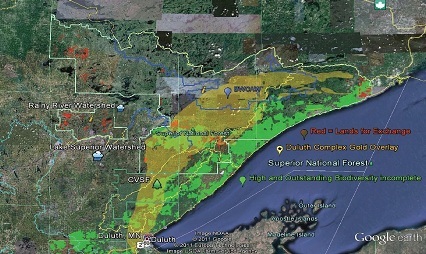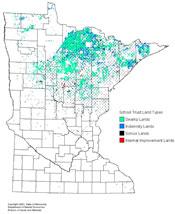Take Action - Stop the Land Exchange!
Harmful to the BWCAW and SUPERIOR NATIONAL FOREST Go to ACTION ALERT!
Sulfide Mining For Our Children?
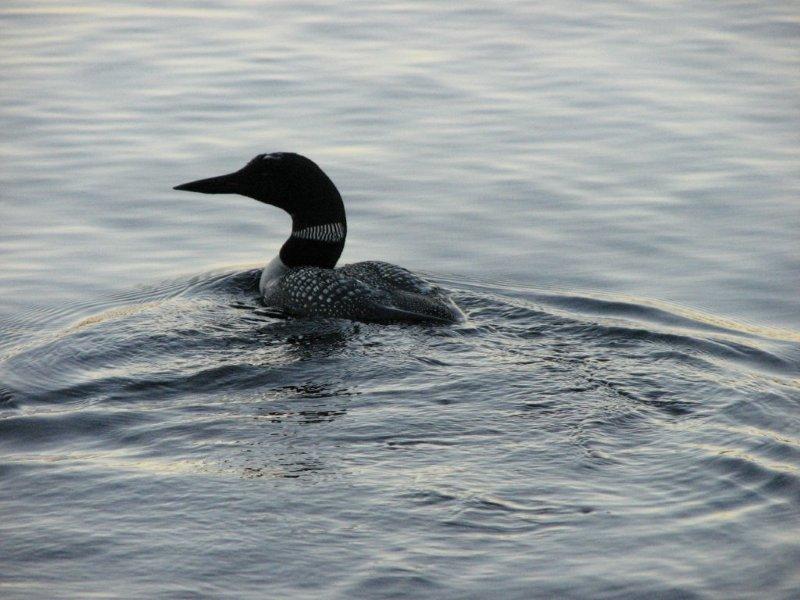
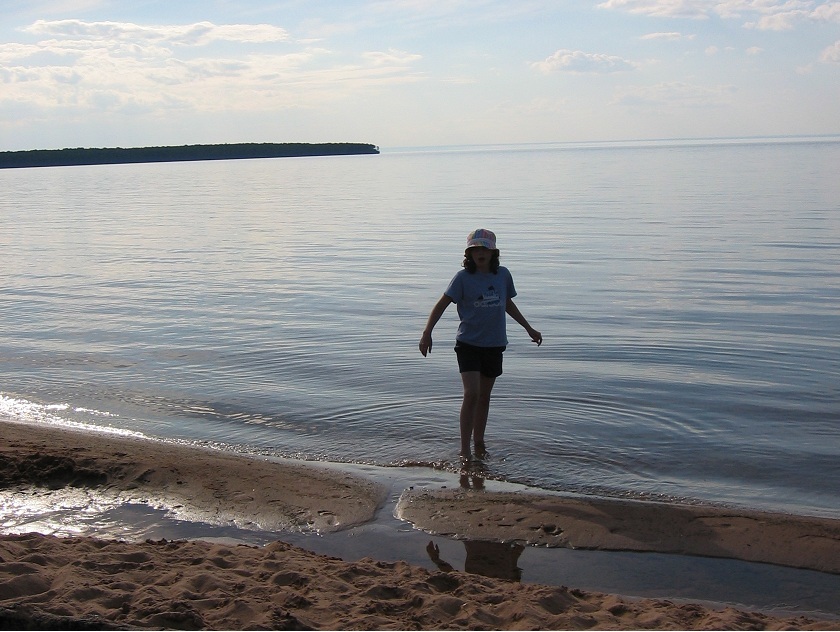
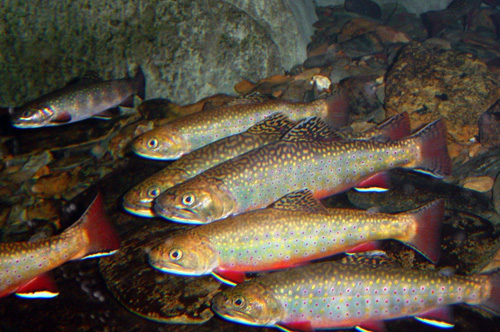
Alert! Cravaack Introduces Special Favors Bill For Mining Companies. Bill Will Allow Tens Of Thousands Of Acres of Protected SUPERIOR NATIONAL FOREST Lands To Be Strip Mined!
H.R. 5544: Minnesota Education Investment and Employment Act
Link to H.R. 5544 HERE more info HERE
Representative Cravaack

MinnPost/Terry Gydesen
Oppose H.R. 5544 which mandates and expedites the transfer of tens of thousands of acres of protected National Forest lands into state management intended to maximize revenue generation. Removing these lands from Federal administration would result in the loss of important protections, including the Weeks Act and other Acts prohibition against strip mining and the National Environmental Policy Act (NEPA) review and appeal process. The underlying purpose of this bill would be to benefit mining companies by removing Federal protections and eluding steps in the standard land exchange process which includes public comment and participation, Native American Tribal consultation, environmental review and appeal.
* * *
Please Contact Senators Franken and Klobuchar, and U.S. Representatives immediately
and ask them to oppose any kind of special favors land exchange legislation.
Stop the give-away of Superior National Forest being proposed in the name of our children!
* * *
According to Rep. David Dill, D-Crane Lake, found HERE
"...we should mine, log, and lease the hell out of that land that we get in the change."

SPECIAL FAVORS FOR MINING COMPANIES Oppose H.R. 5544
Federal legislation has been introduced that would exempt the BWCAW land exchange from the normal land exchange process and National Environmental Policy Act (NEPA) requirements for environmental review and public involvement and input.
***
Legislation that transfers lands out of the Superior National Forest for maximum mineral and natural resources development and exploitation, while removing current Federal protections on the lands would be detrimental to the Superior National Forest and Boundary Waters and would conflict with the intent and purpose of the Boundary Waters Canoe Area Wilderness Act of 1978.
***
The school trust lands in the BWCAW issue is being used to manipulate, change, and control the mineral interests of the Superior National Forest, in order to facilitate turning Minnesota's beloved Arrowhead Region into a copper-nickel sulfide mining district.
***
The laws of the land established to protect the Superior National Forest, including the Boundary Waters Canoe Area Wilderness, the Lake Superior watershed and the entire State of Minnesota, are being weakened by legislation, ignored by governmental agencies, and bypassed through land exchanges.
School Trust Lands Within The Boundary Waters
On 5/8/2012 Rep. Cravaack Introduced H.R. 5544 Minnesota Education Investment and Employment Act found HERE
Background - In a Press Release dated December 9th, 2011, found HERE Congressman Chip Cravaack announced plans to introduce legislation requiring the United States Forest Service to offer a yet-to-be-determined amount of Superior National Forest land to the State of Minnesota in exchange for more than 86,000 acres of School Trust Land within the designated Boundary Waters Canoe Area Wilderness (BWCAW).
Minnesota's Constitution specifies that the Permanent School Fund must be managed for "maximum return”, not that the land itself must be maximized for revenue generation. The Permanent School Fund (PSF) could be receiving a percentage of U.S. Forest Service permit fees for trust lands within the BWCAW. Such a recreational fee was suggested in the 1990’s, but rejected by Iron Range legislators. The majority of Minnesota's school trust lands were sold by the early 1900’s for agriculture and development. The PSF is now worth $750 million. Interest from the fund generates $26 per student, out of approximately $9,000 allocated (state general fund, property taxes, Federal dollars) per student per year. The PSF contributes less than .3% per student. In northeast Minnesota, much of the school trust lands are wetlands, forest, or designated Swamp Lands, which were never meant to generate monies for the trust.
While logging, leasing, land sales, and iron mining have added to the fund over the years, a new type of mining dominates political discourse. Multi-national mining companies are exploring the entire Superior National Forest, between Lake Vermilion and the North Shore, for previously unmarketable low grade copper-nickel sulfide mineralization. Despite the fact that mining of these sulfide ores would leave behind a trail of Acid Mine Drainage, heavy metal pollution, and 99% waste rock, politicians grasp onto mining company projections of the financial benefits to the state while ignoring the long-term consequences and costs of perpetual water treatment and extensive and persistent pollution and environmental degradation.
H.R. 5544 leads the way for other land exchanges. Such is the case with PolyMet whose proposed copper-nickel open pits, though not on school trust land, would lie upon what is now Superior National Forest. According to U.S. Forest Service comments in PolyMet’s Draft Environmental Impact Statement, “It is the position of the United States that the mineral rights reserved…do not include the right to open pit mine the National Forest lands.” PolyMet would thus need special legislation removing current environmental protections in order to open a strip mine on the Superior National Forest.
Rep. Cravaack’s legislation also ignores the fact that many of the Federal lands have severed mineral rights owned by private mining interests, and therefore will not generate money for the school trust if exchanged. Nor does the bill solve the problem of the State's approximately 100,000 acres of severed mineral rights that would remain within the BWCAW; these mineral rights could generate further exchanges and the further dismantling of Superior National Forest. The sole intent of the proposed land exchange is to facilitate the opening of a sulfide mining district on lands bordering the BWCAW and extending through what is now Superior National Forest to Lake Superior.
H.R. 5544 Removes Federal Protections
If passed, the result of H.R 5544 would be the loss of many tens of thousands of acres of Superior National Forest land that would instead be managed by the state of Minnesota for maximum revenue generation. Lands that lie within a designated national forest and are owned by the Federal government have a variety of critical protections, including:
* The National Environmental Policy Act (NEPA) provides a process for public input by affected citizens and environmental review to evaluate and determine whether an action is in the public interest. More info HERE
* The Weeks Act and other Acts protect National Forest lands against surface destruction such as strip mining and protects the headwaters of rivers and watersheds in perpetuity. The National Forest lands were designated for watershed protection and to secure the maintenance of a perpetual growth of forest. More info HERE
* Section 7 of the Endangered Species Act (ESA) requires the Fish and Wildlife Service to consult with proposed projects on National Forest land to ensure ESA compliance. More info HERE
* The Boundary Waters Canoe Area Wilderness Act of 1978 specifically requires that the BWCA be protected from the environmental impacts associated with mineral development "to the maximum extent possible". More info HERE
* The legislation bypasses and ignores Native American Tribal rights and is contrary to laws, policies and Executive Orders requiring government - to - government consultation on issues related to Federal actions. More info HERE
* * * * *
Information and Media on Representative Cravaack's BWCAW legislation
Minneapolis Star Tribune Editorial: Scrutiny needed on BWCA swap - Boundary Waters land deal would mostly benefit industry found HERE
Duluth News Tribune - Cravaack introduces BWCAW land swap bill By John Myers found HERE
Duluth News Tribune Editorial - Save Our Sky Blue Waters found HERE
Reader Weekly - June 1th, 2012 - Bad Deal for the Children, Good Deal for the Mining Companies article found HERE
Subcommittee on National Parks, Forests and Public Lands Legislative Hearing on H.R. 5544 - Comments Submitted Re: H.R.5544 THE MINNESOTA EDUCATION INVESTMENT AND EMPLOYMENT ACT, Friday, June 8, 2012 found HERE
Comments Bad Deal for the Children, Good Deal for the Mining Companies found HERE
Save Our Sky Blue Waters (SOS) & Save Lake Superior Association (SLSA) & Friends of the Cloquet Valley State Forest (FCVSF) Position Statement on Minnesota School Trust Lands in the BWCAW found HERE
Sierra Club North Star Chapter - Cravaack opposition letter found HERE
Quetico Superior Foundation - Cravaack to Introduce Land Exchange Bill found HERE
Western Lands Project - Update - Summer 2012 - Minnesota: Land Trade Bill Would Foster Open-Pit Mining found HERE
Media on School Trust Lands Within the BWCAW
MinnPost - Exchanging school trust lands isn't 'for the sake of our children' By Elanne Palcich found HERE
MinnPost - Would better DNR management bring more money for schools? By Beth Hawkins found HERE
Minneapolis Star Tribune - Minn., feds close on deal for state land in BWCA found HERE
Op-ed FOR THE SAKE OF OUR CHILDREN: THE SCHOOL TRUST ISSUE By Elanne Palcich found HERE
Minnesota Public Radio (MPR) - Disagreement threatens to derail plan to swap school trust lands found HERE
Rep. David Dill, D-Crane Lake said. "...we should mine, log, and lease the hell out of that land that we get in the change."
* * * * *
H.R. 5544 IS NOT IN THE PUBLIC INTEREST AND IS BAD PUBLIC POLICY
Special significance of BWCAW inholdings
When the boundaries of the Boundary Waters Canoe Area Wilderness were established, as part of the Wilderness Act of 1964 and the Boundary Waters Wilderness Act of 1978, roughly 100,000 acres of state land remained within the wilderness. Today there remains 86,000 acres of school trust land inholdings in the BWCAW, because no logging or mining is allowed within the wilderness, there has been limited revenue generation for the school trust fund. Note that the school trust could be receiving a percentage of U.S. Forest Service user permit fees for trust lands within the BWCAW. Also note that approximately 22,000 of these acres are Swampland Act additions and were not meant to generate funds for the school trust.
The northeast Minnesota "Range" delegation has worked to prevent the sale of these state lands to the Federal government. Instead the Range delegation wants a land-exchange. Because the lands within the designated wilderness of the BWCAW are highly valued, a greater number of acres outside of the BWCAW may be sought as part of an exchange. These lands would come out of the Superior National Forest. In the 1990’s, the Range delegation sought an exchange that would allow the state to do more intensive logging on lands that border the BWCAW. But promises of a new windfall appear to have united the Republican-led Minnesota legislature and Range Democrats. Mining companies are exploring for copper-nickel sulfides, and other trace metals in the Duluth Complex of mineralization that underlies the Superior National Forest and borders of the BWCAW.
Problematic footprint of sulfide mining
Mineral prospecting and proposed mining of the low-grade, highly disseminated mineralization of the area is controversial. Because the ore body is so low grade, mining would result in 99% waste rock; open pits, waste rock piles, dikes and tailings basins would replace the forests and wetlands of Superior National Forest. Sulfides in the waste rock and tailings would react with air and water to eventually form sulfuric acid (H2SO4). Acid mine drainage (AMD) and leaching of unrecoverable heavy metals in the waste rock and tailings would contaminate ground and surface water flowing into two watersheds: east into Lake Superior or north into the BWCAW and the Rainy River. AMD and heavy metal contamination would require near-perpetual treatment, for centuries. Even so, it has proven impossible to prevent the leaking of tailings basins, run-off from waste rock piles, and toxicity of open pits.
Legacy of mining
The legacy of Superior National Forest and the BWCAW, lands currently protected and preserved for the citizens of this nation, would be lost to an industrial wasteland. Expansion of proposed taconite mining on the Iron Range, in conjunction with proposed sulfide mining in what is now Superior National Forest, would destroy the heritage that is currently being held in trust for our children and future generations.
Legacy of the trust
The school trust lands currently within the BWCAW do not need to be traded. They could be sold directly to the Federal government; funds are available from the Land and Water Conservation Fund or other funds. Because the land within the BWCAW is highly valued, it could be sold at a high price, immediately adding money to the PSF. Even though current interest rates may be low, the amount of money added to the fund would generate significant funding. In addition, the state may be able to find ways to generate additional moneys through recreational fees, as is done in Montana. A land sale or BWCAW user fee would preserve both the legacy of the school trust fund, and the legacy of the Superior National Forest.
Ethics
It is unethical and immoral to base the education of our school children upon the destruction of the land that is their true heritage. In addition, there is no guarantee that sulfide mining will be deemed environmentally acceptable in northeast Minnesota, or that the market will sustain the mining of less than 1% ores. There has been no public discussion regarding the outsourcing of these metals to China and other countries, along with the outsourcing of profits by foreign mining companies.
Also, any land exchange would cover only the surface rights, not the mineral rights to the land within the BWCAW. This oversight could eventually hold the door open for mining within the BWCAW itself, something currently restricted by law. There is no mention being made of who would ultimately be responsible for mining clean-up costs or the costs of near perpetual treatment on school trust lands.
Legislators have jumped on a bandwagon that promises jobs and trust fund moneys, while burying the true impacts upon the land and its sustainability, water as a precious resource, the health of all of us who depend upon clean air and water, and the wilderness heritage of northeast Minnesota that remains as a vestige of what once covered this state and country.
Summary
We ask our Federal legislators to facilitate a total land sale of the remaining state inholdings within the BWCAW to the Federal government. We oppose any type of land exchange or partial land exchange as against the best interests of the school children of the state of Minnesota, and the future generations of this state and nation. The school trust could collect a percent of the BWCAW user fee currently charged to wilderness visitors by the U.S. Forest Service. With the BWCAW user fee scenario, the State would continue to own the land in the Boundary Waters and would continue to have a voice in management decisions.
We believe in the importance of public education, and that it be funded through a steady and reliable source of income. Public education should not be dependent upon mining which has never before been permitted in this state, and which, if permitted, would be susceptible to market fluctuations, and which would ultimately degrade the environment for all future generations.
* * * * *
Background Information
When Minnesota became a State in 1858 the Federal government granted sections 16 and 36 of every township to the State to be held in trust "for the use of schools". The State could use, lease, or sell the land to raise money for education. The original Federal school land grant consisted of 2.9 million acres of land. The State later added lands acquired through the Federal Swamp Land Act and other Federal lands grants, to the school trust lands portfolio. The State administers these other land grants as if the "for the use of schools" agreement applies equally, though the Federal non-school land grants were for different purposes. Note - These departures from the terms of the swampland grant were apparently never questioned or challenged by Congress. This resulted in a peak of 8.1 million acres. The Minnesota Constitution established the Permanent School Fund (PSF) to ensure a long-term source of funds for public education in the State. The PSF consists of the accumulated revenues generated from various Federal land grants. The Department of Natural Resources (DNR) was given responsibility for managing school trust land, much of which had been sold by the mid-1880s. The DNR currently manages about 2.5 million acres of school trust land and an additional 1 million acres of severed mineral rights. The principal of the PSF consists of cash generated from the trust lands, not including the value of the trust land. Income is primarily earned from land and timber sales, land leases, and mineral royalties.
"School Trust Lands" in the BWCAW consist of:
Swamp Land = 23,000 acres; Indemnity = 21,000 acres; and school lands = 42,000 acres.
* * * * *
USFS Environmental Review Status Unknown - Craavack's legislation would bypass the normal environmental review process and mandate that the exchange take place.
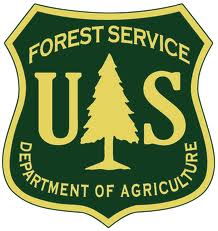 Superior National Forest - School Trust Fund Lands Within the Boundary Waters
Superior National Forest - School Trust Fund Lands Within the Boundary Waters
From the USFS - School Trust Fund Lands Within the BWCAW Status: February 2012 found HERE
The State of Minnesota and the USDA Forest Service are working together on a mutually beneficial strategy to transfer ownership of approximately 86,000 acres of currently designated school trust lands, located within the Boundary Waters Canoe Area Wilderness (BWCAW) on the Superior National Forest, to federal ownership as part of a combined purchase and land exchange agreement.
The intent of this strategy is to allow the State to obtain land that is not limited by Wilderness designation and which may be managed to meet the objectives for school trust lands to generate revenue for the maintenance of public schools in Minnesota. At the same time, the Forest Service is interested in opportunities to consolidate ownership and places a priority on acquiring non-federal lands within the BWCAW.
Beginning in 2010, the Minnesota Legislature’s Permanent School Trust Fund Advisory Committee appointed a working group comprised of representatives from the Forest Service, the State of Minnesota, and interested stakeholders including representatives of: the school trust, environmental groups, timber industry, mining interests, and local government officials. The working group collaborated through 2011 to identify parcels of national forest lands, located outside of the BWCAW, on the Superior National Forest as candidates for land exchange/acquisition.
The information on the attached maps was presented to the Advisory Committee on December 9, 2011. The maps identify federal land candidates considered for potential exchange at this point in time. More work will be done prior to making specific proposal recommendations to the legislature. The Forest Service will conduct environmental analysis and public involvement prior to actual transfer of lands if the state legislature approves a specific proposal.
Below is a key map identifying detailed maps of candidate parcels. Determine which map you wish to see and click on on the corresponding link below the map for the map of parcels in that section.
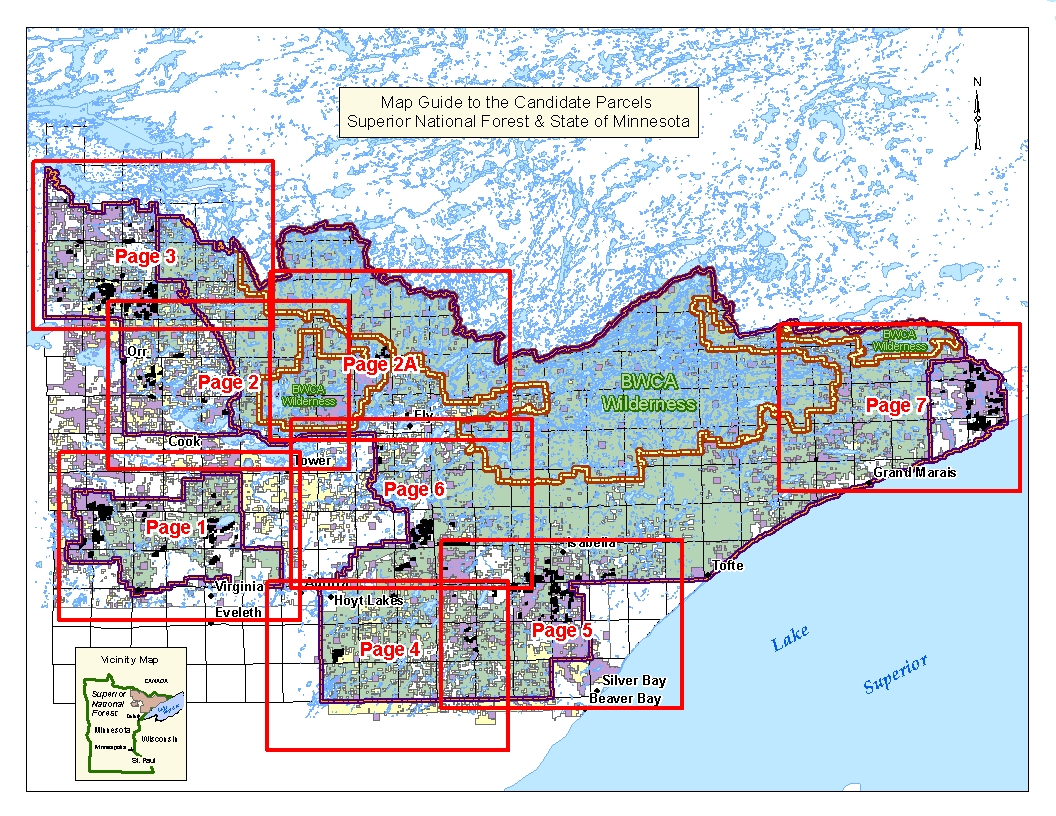
| Page 1 | Page 4 | |
| Page 2 | Page 5 | |
| Page 2A | ||
| Page 3 | Page 7 |
Map of Lands USFS may acquire in the potential exchange
* * * * *
Disposition of School Trust Lands in the Boundary Waters
Map of proposed lands in the BWCAW exchange - source FCVSF
FEDERAL PURCHASE OF ALL SCHOOL LANDS IN THE BWCAW / BWCAW USER FEE
Desired Outcome: The Federal government’s purchase of the State's school lands in the Boundary Waters. Alternatively, the school trust could collect a percent of the BWCAW user fee currently charged to wilderness visitors by the U.S. Forest Service. With the BWCAW user fee scenario, the State would continue to own the land in the Boundary Waters and would continue to have a voice in management decisions. The sale-only and BWCAW User Fee options protect the Superior National Forest (including the Boundary Waters) and is financially responsible to the original school land agreement by raising guaranteed revenue for the Permanent School Fund (PSF). Funds for a sale would most likely be secured through a cash payment from the Federal government from dedicated funds such as the Land and Water Conservation Fund.
FEDERAL PROTECTIONS WILL BE REMOVED AND BYPASSED
The connection to controversial sulfide mining is obscured in the BWCAW exchange by focusing on the school trust land issue. The main objective is the elimination of the current Federal protections on the Superior National Forest lands - in advance of mining. Exchanging USFS lands outside of the BWCAW for State land within the BWCAW means those lands would no longer be part of the National Forest and therefore not be subject to USFS management plans, policies and laws. This would include existing Federal Weeks Act and other Acts protections on the National Forest lands against destroying the surface and protecting the headwaters of rivers and watersheds that were meant to last into perpetuity.
Additionally, the exchanged Federal lands would no longer be subject to the National Environmental Policy Act (NEPA), Section 7 of the Endangered Species Act and the Superior National Forest Plan. The school trust lands in the BWCAW exchange issue is being used to manipulate, change, and control the mineral interests of the Superior National Forest, in order to facilitate the DNR Division of Lands and Minerals' plan to turn Minnesota's Arrowhead Region into a copper-nickel sulfide mining district.
SEVERED MINERAL RIGHTS AND SPLIT ESTATES ARE NOT BEING ADDRESSED
The mineral rights for the State lands in the BWCAW are not being exchanged. How will that affect land usage in the future? Apparently, eighty-six thousand acres of the State’s mineral rights will remain in the BWCAW, even as the surface rights are exchanged. At a later date, will demands for compensation be made by the State of Minnesota for the severed mineral rights within the BWCAW? The split mineral estate of the lands is a critical, precedent setting issue that is not being addressed in the proposed exchange.
How would this affect trust fund moneys? Would the trust fund be held responsible for pollution clean-up costs for mines that may require near perpetual treatment? What about the Federal lands outside the BWCAW that would be exchanged out of Federal protections? An exchange is a windfall for mining companies who own but cannot fully exercise their mineral rights on National Forest lands where strip mining is banned. An exchange is an unfair advantage to mining companies by removing existing Federal protections on the lands in advance of mining and bypassing the normal environmental review process.
THE CUMULATIVE IMPACTS OF THE LAND EXCHANGES ARE NOT BEING ADDRESSED
The USFS must consider the impact on the environment which results from the incremental impact of the action when added to other past, present, and reasonably foreseeable future actions regardless of what agency (Federal or non-Federal) or person undertakes such actions (40 CFR 1508.7). It must also consider exchanging lands within the BWCAW for a currently unknown amount of land outside the BWCAW (greater than a 1:1 exchange since land in the BWCAW is considered to be of higher value). A disproportionate amount of the Superior National Forest in the Lake Superior watershed is expected to be removed from Federal ownership and protections in a land exchange process, with the potential to significantly impact the watershed and reduce the size of the Forest. Federal legislation bypasses the normal Forest Service land exchange process and circumvents public environmental review, appeal and agency protections.
MINING IS SPECULATIVE; A SALE OR USER FEE IS A GUARANTEED SOURCE OF REVENUE FOR THE SCHOOLS
No mine is yet permitted within what is now the Superior National Forest. Although minerals exploration is pervasive throughout the Arrowhead, the underlying geologic complex consists of low-grade highly disseminated metals which are very costly to extract and over 99% of the mined material would be "waste". The economic feasibility of mining such ores is dependent upon the price of the metals in relationship to the cost of mining them. A sale or user fee would immediately place money in the PSF, generating interest money to be used by the schools.
WHO WOULD BE RESPONSIBLE FOR CLEAN-UP AND PERPETUAL TREATMENT FROM THE MINING OF SULFIDE ORES ON SCHOOL TRUST FUND LANDS?
Sulfide mining has as track record of contaminating the environment with sulfuric acid and heavy metals. Past mining operations have indicated that financial assurance required for permitting is routinely underestimated. In addition, mining companies often go bankrupt, leaving enormous clean-up costs to taxpayers. Water treatment post-mining usually requires indefinite or “perpetual” treatment.
HOW DOES DESTROYING THE LAND AND POLLUTING THE WATER BENEFIT OUR CHILDREN?
What we need is a common sense state plan for funding public education without destroying the value of our land for the children of the future. If public education is one of the main priorities of our government, then education money should come from the general fund. It is unethical and immoral to base the education of one generation of children upon the destruction of land for the next generation of children. Once land has been mined, it has no future value. Instead it pollutes our air and water, especially affecting the development of our children at the most vulnerable stages of their lives.
Sulfide Mining District planned for Minnesota's Arrowhead Region
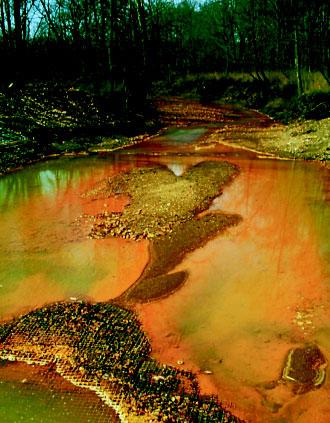

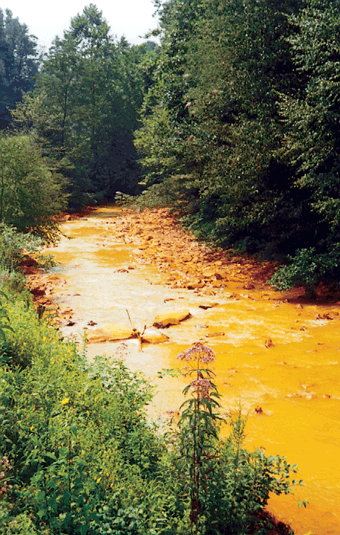
Acid Mine Drainage (AMD) and Heavy Metals in streams - USGS, EPA
Metal Mining Pollution
Hardrock Mining: Risks to Community Health by Boulanger & Gorma found HERE
The Price of Pollution Cost Estimates of Environment - Related Childhood Disease in Minnesota - MCEA & IATP found HERE
CSP2 FACT SHEETS HEALTH & ENVIRONMENTAL EFFECTS OF TRACE ELEMENTS IN METAL-MINING WASTES found HERE
Mining & Health: A Community-Centered Health Assessment Toolkit from the Canary Research Institute found HERE & HERE
Overburdened: Understanding the Impacts of Mineral Extraction on Women's Health in Mining Communities found HERE
EPA - Managing Environmental Problems at Inactive and Abandoned Metals Mine Sites (very large file) found HERE
* * * * *
Disposition of School Trust Lands in the Boundary Waters
In Summary
• In 1997, the entire Minnesota Federal legislative delegation supported a buy-out of all school lands within the BWCAW. At that time, money was available from the Land and Water Conservation Fund. This initiative failed when the northeastern Minnesota State delegation demanded a full land exchange. Their argument was that money could be generated for the School Trust Fund by more aggressive logging on land the state would receive in the exchange process.
• As a result of northeastern Minnesota political meddling, the process was stymied and no money has been generated for the School Trust Fund inholdings during the interim.
• Northeastern Minnesota politicians are again interfering with the process of a land sale, with money available from dedicated Federal funds. This time around, the politicians want to exchange state land within the BWCAW for Federal lands where mineral exploration is taking place.
• Removing these lands from Federal ownership would mean removing the Week’s Act and other Acts protection against strip mining, National Environmental Policy Act provisions, and Section 7 of the Endangered Species Act.
• The Range delegation is using the issue of school trust money to promote the mining of copper-nickel bearing sulfide ores on land near the BWCAW, even though such mining is known to contaminate the environment. There is no sulfide mine in existence that is not polluting the ground water. Contamination from sulfide ores continues for centuries, as is indicated by acidic pollution still being generated by a Roman mine.
• No such mine has yet been permitted in Minnesota; there is no guarantee that the citizens of this State and Country will accept the mining of sulfide ores bordering the BWCAW and within the Superior National Forest and the Lake Superior watershed.
• The highly disseminated low-grade ores of Minnesota’s Duluth Complex of mineralization are economically marginal, which is why they haven’t been mined previously. Such mining is highly energy intensive, making the industry susceptible to market fluctuations and energy costs.
• While there is no guarantee of money to be generated for the School Trust Fund from mining ventures, a land sale would generate almost immediate money for the fund. According to State law, only interest from the fund can be used on a yearly basis, keeping the fund itself intact for future generations.
• Additional sources of funding might include a recreational fee for users of the BWCAW lands. This has been done in western states to generate money on school trust fund lands.
• Once land has been mined, or heavily logged, it no longer retains value for recreational or other uses.
• The Federal lands of Minnesota’s Arrowhead were left to the citizens of this Nation, as well as to our own children, as an historical legacy. They are but a small remnant of the vast forests that covered the State prior to the 1900’s.
• Pollution from the mining of these lands would affect both the Lake Superior watershed and the BWCAW, part of the Rainy River watershed.
• It is unethical to base our children’s education on a mining industry that would destroy the heritage of the Arrowhead for future generations, and that would pollute sources of clean water, a resource of great significance in its own right.
• A smaller Superior National Forest would result in a reduction of Federal “Payments in Lieu of Taxes” (PILT) made to our counties as these payments are appropriated from the U.S. Treasury. A trade would reduce gross revenues (before expenses) from logging, etc., which are shared by the Forest Service with local schools and counties.
• More local school funding and road maintenance, lower property taxes, Federally-funded forest restoration, and a more sustainable quality of life for future generations would be provided by Federal purchase of State school lands locked in the Boundary Waters.
• Support of a total land sale of any remaining State school lands within the BWCAW borders. The land exchange that is being proposed, is not in the Public Interest or in the best interest of the children of our State and the citizens of our Nation.
• When the forest reserves were transferred to the Department of Agriculture in 1905 the Secretary of Agriculture issued the following mandate to the first Chief of the Forest Service: " All land is to be devoted to its most productive use for the permanent good of the whole people, and not for the temporary benefit of individuals or companies. Where conflicting interests must be reconciled, the question will always be decided from the standpoint of the greatest good of the greatest number in the long run". Dismantling and mining the Superior National Forest does not meet this criteria.
Additional Background Information
DNR’s Management of School Trust Land
In 1985, the Legislature adopted the following goal for management of school trust land:
127A.31 GOAL OF THE PERMANENT SCHOOL FUND.
The legislature intends that it is the goal of the permanent school fund to secure the maximum long-term economic return from the school trust lands consistent with the fiduciary responsibilities imposed by the trust relationship established in the Minnesota Constitution, with sound natural resource conservation and management principles, and with other specific policy provided in state law.
<FN- Minn. Stat. §127A.31.>
In addition to maximizing the long-term economic return, this goal allows the DNR to manage school trust land to serve the public benefit by providing recreational opportunities, wildlife habitat, and other values consistent with natural resource management principles. This statute recognizes that a sustainable natural resource base is essential for long-term revenue generation from the school trust lands and that maximizing returns for short term gains could deplete the revenue generating potential of the school trust lands. This statute requires the DNR to maximize revenue generation from the school trust lands, while managing the lands with sound natural resource conservation and management principles. To comply with this statute the DNR must balance the goal of maximizing revenue generation with the goal of sound natural resource conservation. (Source - DNR)
Minerals Management
The DNR Division of Lands and Minerals administers about 3.4 million acres of school trust mineral rights. School trust lands account for about one-third of total (12.4 million acres) State-owned mineral rights acreage leased and about one-fifth of the total revenues received from State mineral leases. In addition to the dominant iron ore and taconite leases, the DNR administers metallic minerals, peat, and industrial mineral leases. In 2011, approximately 46,000 acres of school trust lands were under a metallic mineral lease and roughly 6,000 acres of school trust lands leased for iron ore and taconite. Of the total state metallic mineral leases approximately 1/3rd is on school trust lands and approximately half of State iron ore and taconite leases are on school trust lands.
Approximately 86,000 acres of school trust land (including acquisitions through the Federal Swamp Land Act) are located in the Boundary Waters Canoe Area Wilderness (BWCAW). Development activities in the BWCAW are severely restricted. This land does not generate revenue for the trust at this time, but could through a user fee. State and Federal officials are planning the Federal government’s mixed purchase and exchange option to remove school trust lands from the BWCAW.
From the Minnesota Department of Natural Resources found HERE
School Trust Lands
What are School Trust Lands?
When Minnesota became a state in 1858, sections 16 and 36 of every township were granted to Minnesota from the federal government to support schools. Alternative sections, referred to as Indemnity Lands, were granted when sections 16 and 36 had already been claimed, were reserved for an Indian reservation, or were under water. The grant ultimately resulted in 2.9 million acres being given to the state for the use of the public schools. By 1900, much of this land had been sold to support public schools. Also included in school trust lands today are remaining lands from two other federal land grants: the Swampland grant of about 4.7 million acres in 1860, and the Internal Improvement grant of 500,000 acres in 1866. Today 2.5 million acres of school trust lands and an additional 1 million acres of mineral rights remain and are managed by the DNR.
School trust land by type of grant
|
||
Type of grant |
Original acres granted |
Remaining acres |
School |
2,900,000 |
957,818 |
Swamp |
4,706,503 |
1,550,818 |
Internal Improvement |
500,000 |
6,510 |
Total |
8,106,503 |
2,515,146 |
The DNR manages the school trust lands for maximum long-term economic return under sound natural resource and conservation practices. Revenues generated from school trust lands are credited to the permanent school fund which is managed by the State Board of Investment. Interest and dividends from the permanent school fund are transferred twice a year, by Minnesota Management & Budget, to all school districts of the state.
The vast majority of school trust lands are concentrated in the northeast quarter of the state. Much of the land is intermixed with county, federal, private, and other state lands. School trust lands are owned by the state in trust for all public schools of Minnesota, they are not owned by the local school district.
From the Minnesota Historical Society archives found HERE
ADMINISTRATIVE HISTORY OF THE SWAMP LAND GRANTS
By congressional acts of September 28, 1850, and March 12, 1860 (12 Stat. 3), Minnesota
(as well as 14 other states) was entitled to select from the federal public domain all swamp land,
and land subject to overflow, in the state. After the state surveyor general had identified tracts of
swamp land, they were patented from the federal government to the state, based on the surveyor’s
notes.
The Swamp Land Acts specifically provided that proceeds from the sale of these lands be
used “so far as might be necessary” to recover the expenses of constructing levees and drains to
reclaim the land for agriculture. However, Minnesota regranted about one-third of the
swamplands to railroad companies to aid in the construction of their lines. Smaller grants were
made for other public purposes, primarily to help support construction of the state’s public
institutions (state schools, insane asylum, and prison). In 1881, an amendment to the state
constitution provided that the remaining swamplands be sold in the same manner as school lands,
and the proceeds placed in a permanent trust fund for the support of educational institutions.
These departures from the terms of the swampland grant were apparently never questioned
or challenged by Congress.
Bibliography: For additional information, see Samuel Trask Dana, et al.,
Minnesota Lands (American Forestry Association, 1960).
* * * * *
Sulfide Mining For the Children?
Tar Creek Superfund Site
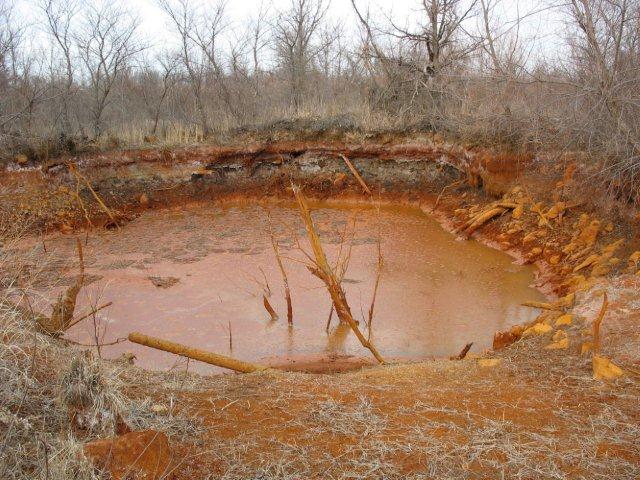
Acid Mine Drainage (AMD) at Tar Creek Superfund Site - EPA
Picher, Oklahoma Ghost Town on Wiki HERE
TAR CREEK, the movie Found HERE
Tar Creek Superfund site - Once one of the largest lead and zinc mines on the planet, Tar Creek is now home to more than 40 square miles of environmental devastation in northeastern Oklahoma: acid mine water in the creeks, stratospheric lead poisoning in the children, and sinkholes that melt backyards and ball fields. Now, almost 30 years after being designated for federal cleanup by the Superfund program, Tar Creek residents are still fighting for decontamination, environmental justice, and ultimately, the buyout and relocation of their homes to safer ground. As TAR CREEK reveals, America’s Superfund sites aren't just environmental wastelands; they’re community tragedies, too. Until the community fights back.
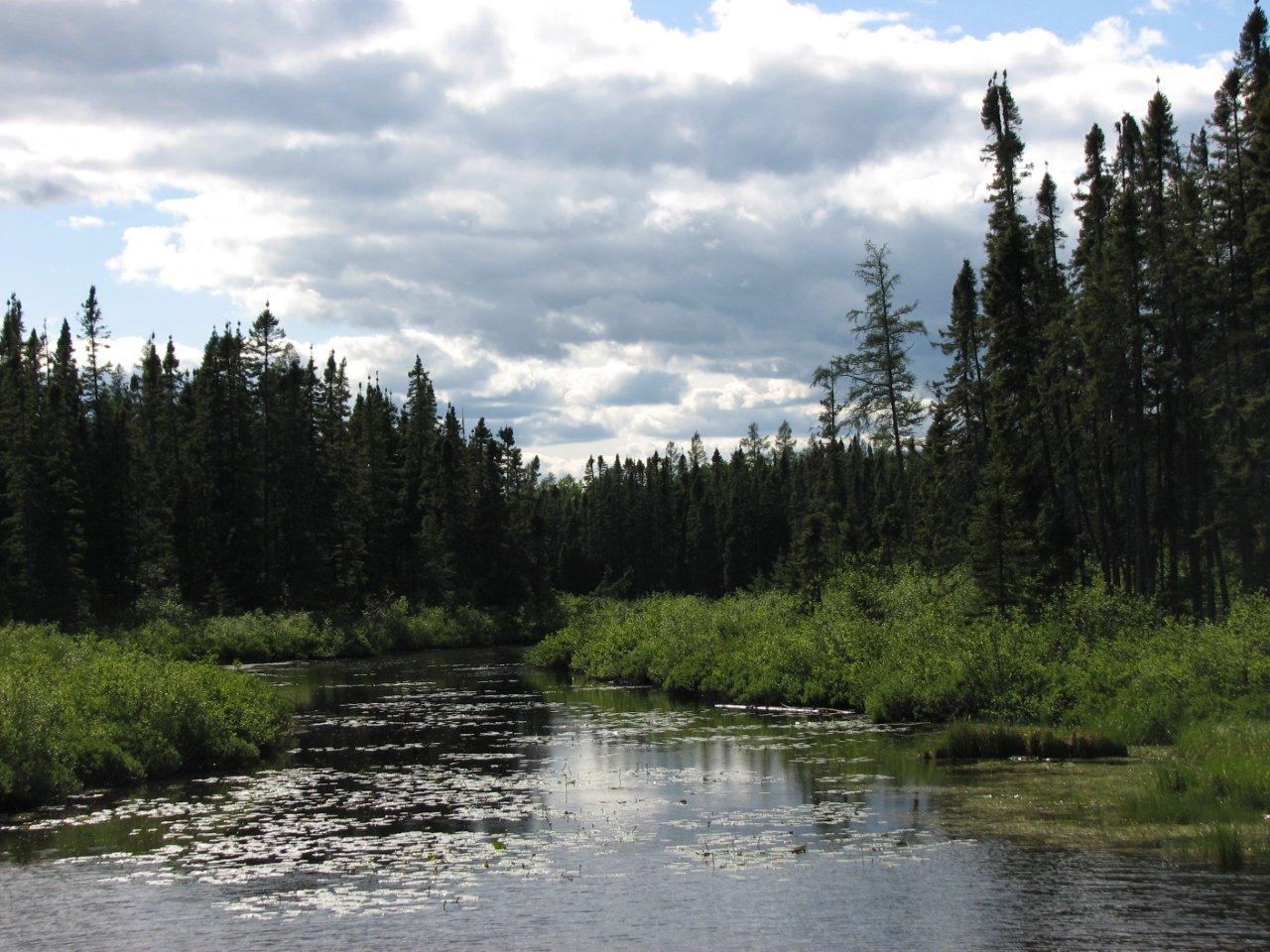
Superior National Forest - Lake County, Minnesota.
Site of intense exploration and leasing for metallic sulfide minerals.
This land was made for you and me.



